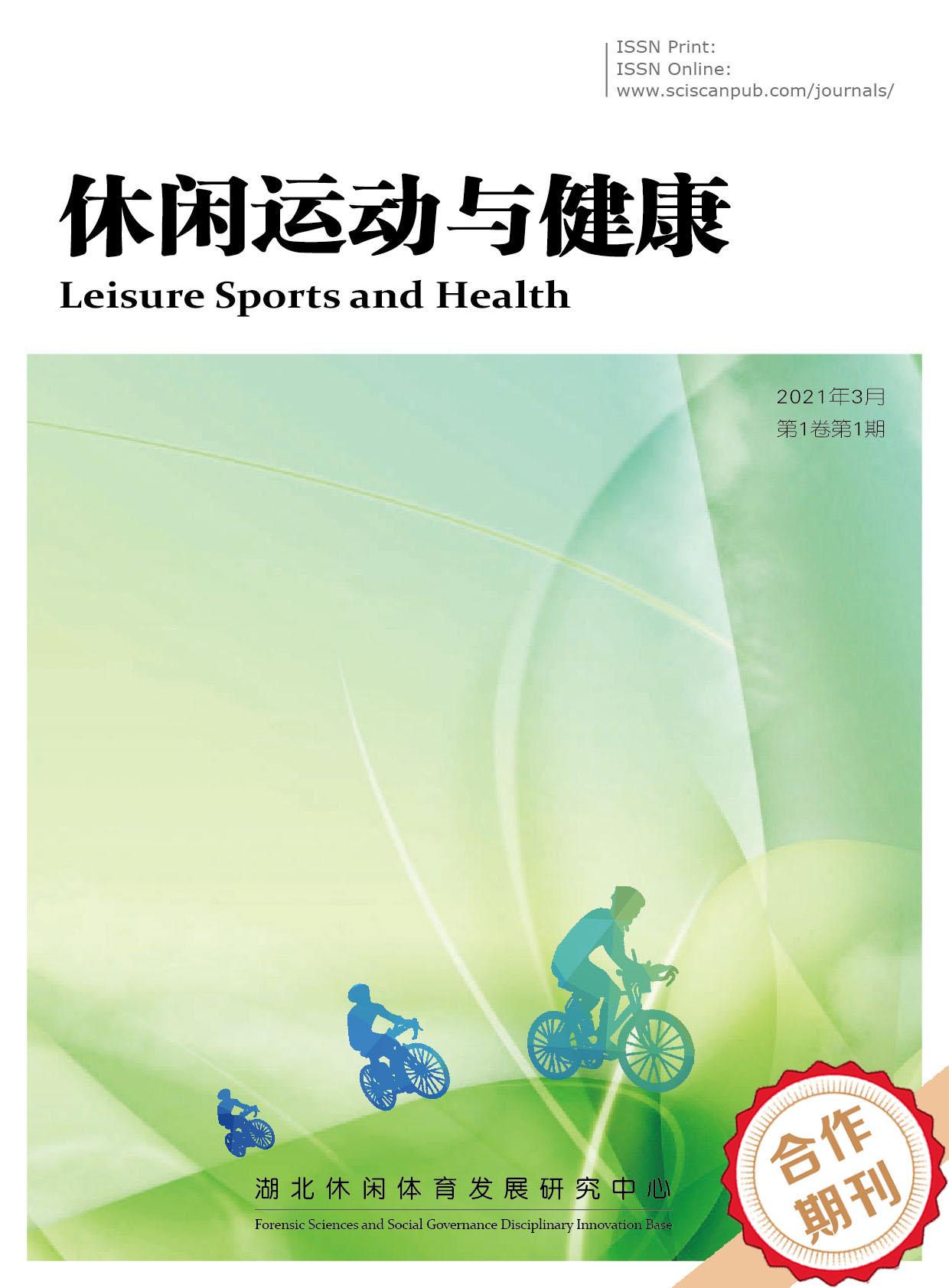Leisure Sports and Health
湖北省射击运动员枪噪声听觉防护意识研究
A Study on Awareness of Auditory Protection against Gun Noise in Shooting Athletes in Hubei Province
- Authors: 孙玉全 梅慧娴
-
Information:
湖北大学体育学院,武汉
-
Keywords:
Shooting athletes; Gun noise; Hearing; Consciousness of protection射击运动员; 枪噪声; 听觉; 防护意识
- Abstract: Background: The high noise training environment in shooting sports poses a potential threat to athletes' hearing health, and raising the awareness of hearing protection among shooting athletes is of great importance for protecting their hearing. Objective: To understand the basic situation of gun noise exposure and hearing loss among shooting athletes, to explore their attitudes and awareness towards the impact of gun noise and to analyze and evaluate them, and to provide theoretical guidance for the prevention and protection of shooting athletes' auditory health. Methods: Between January and July 2023, by tracking the shooting team of Hubei Province, 42 qualified Hubei Province shooting team athletes were selected as the research objects, and questionnaires were filled in and pure tone audiometry tests were conducted. The BD-Ⅱ-116 type of auditory experiment instrument, which had been adjusted and calibrated, was used to conduct bilateral air conduction pure tone detection of the athletes in a noise <30dB room to judge the athletes' speech frequency hearing loss (>20dB) and high frequency hearing loss (>20dB). And the correlation between protective awareness and the athlete's auditory characteristics was studied. Results: (1) The size of the athlete's hearing protection awareness is related to the training year (χ2=5.839, p=0.016) and gun type (χ2=8.145, p=0.004), and the athletes with longer training years and caliber gun types have higher hearing protection awareness. The hearing protection awareness of shooting athletes with ear ringing is higher than that of athletes without ear ringing (χ2=7.0, p=0.008). (2) There is a good consistency between the exposure to gunshot noise and the cognition of noise among shooting athletes. The subjective judgment of gun noise by athletes is positively correlated with their awareness of auditory protection (R=0.403, p=0.008), and the cognition of gun noise and awareness of auditory protection are positively correlated (R=0.402, p=0.008). (3) Compared with other factors (such as the risk of noise-induced hearing loss), the reminder and supervision of coaches play a more critical role in athletes' persistence in using hearing protection devices. Conclusion: Although most athletes have certain cognition and awareness of gun noise in shooting, this protective awareness only stays at the cognitive level and has not been well implemented in practice. Coaches and relevant personnel should strengthen noise protection and hearing health education for shooting athletes, enhance their awareness of auditory protection, and supervise them to wear hearing protection measures during training to protect their hearing health. 背景:射击运动的高噪音训练环境对运动员听力健康存在潜在影响,提高射击运动员听力防护意识对保护运动员听力具有重要意义。目的:本研究旨在了解射击运动员枪噪声暴露及听力损失的基本情况,探讨射击运动员对枪噪声影响的防护态度和意识,并进行分析与评价,为枪噪声的防治和保护运动员听觉健康提供理论指导。方法:在2023年1月至7月期间,通过对湖北省射击队的跟踪调查,筛选出42名符合条件的射击队运动员作为此次研究对象。通过填写调查问卷及进行纯音测听实验,使用校准后的BD-Ⅱ-116型听觉实验仪器在噪声<30dB的房间内对运动员进行双耳气导纯音检测,评估运动员的语频听力损失情况(>20dB)和高频听力损失情况(>20dB),并研究防护意识与运动员听觉特征的相关性。结果:(1)运动员听觉防护意识的大小与训练年限(χ2=5.839,p=0.016)和枪支类型(χ2=8.145,p=0.004)有关,训练年限长和口径类枪种的运动员听力防护意识较高;有耳鸣情况发生的射击运动员听力防护意识比无耳鸣情况运动员高(χ2=7.0,p=0.008);(2)射击运动员噪声暴露与对噪声的认知之间存在较好的一致性,运动员对枪噪声的主观判断与听觉防护意识之间亦呈正相关(R=0.403,p=0.008),对枪噪声的认知和听觉防护意识之间呈正向相关性(R=0.402,p=0.008);(3)与其他因素(如发生噪声性听力损失的风险)相比,教练员的提醒和监督在运动员坚持使用听力保护设备方面发挥着较为关键的作用。结论:尽管大多数运动员对射击的枪噪声具有一定的认知和防范意识,但这种保护意识多停留在认知层面,没有很好地落实到行动当中,教练及相关人员应加强对射击运动员的噪声防护和听觉健康宣教工作,提高其听觉防护意识,做好运动员训练中佩戴听力防护设备的监督,以保护运动员听觉健康。
- DOI: https://doi.org/10.35534/lsh.0402016
- Cite: 孙玉全,梅慧娴.湖北省射击运动员枪噪声听觉防护意识研究[J].休闲运动与健康,2024,4(2):93-97.
噪声性听力损失(NIHL)是一个重要的社会和公共卫生问题。早在1997年,世界卫生组织(World Health Organization,WHO)就将发展中国家的NIHL确定为听力损伤的一个日益增加的风险因素[1]。听力损失的危害波及全人群,会对生活的诸多方面产生影响。它不仅阻碍儿童的言语和认知发育,影响青中年的学习、就业、生活和社会融合,也导致老年人情绪压抑、沟通和认知障碍,进而带来事故、生产力下降和社会孤立等一系列问题。尽管噪音暴露的主要影响自20世纪60年代以来已为人所知,但截至目前,噪音暴露的预防和治理工作仍然是一个巨大的社会难题[2]。高强度和短瞬时的枪噪声作为射击项目的一大特点,对运动员听力健康构成了挑战。由于射击运动员每天训练时长超过五小时,巨大的枪噪声以及场馆内的回音对运动员的听力造成一定伤害。尽管存在一些关于噪音对运动项目影响的研究,但是针对射击运动员这一独特群体的研究鲜有报道。本文旨在通过了解射击运动员对枪噪声的认识和对枪噪声防护意识的不同情况,对不同特征的射击运动员听觉防护意识进行分析,探讨影响运动员听觉防护意识的主要因素,并分析各类因素与听觉防护意识之间的关联性,为枪噪声的防治和保护运动员听觉健康提供理论指导。
1 对象与方法
1.1 研究对象
在2023年1月至7月期间,在湖北省体育局射击训练中心筛选出42名符合条件的射击运动员作为此次研究的对象,发放调查问卷并进行纯音测听实验。研究对象的纳入标准包括:(1)近6个月内均正常参加射击训练且有意愿参与此次实验;(2)半年内听力没有受过除训练外的高强度噪音影响;(3)没有遗传性耳病、听力损失家族遗传史、服用耳毒性药物或耳部感染等情况。
表 1 研究对象基本情况分析
| 变量 | 分组 | 人数 | 构成比(%) |
| 性别 | 男生 | 24 | 57.1 |
| 女生 | 18 | 42.9 | |
| 年龄 | ≥18岁 | 15 | 35.7 |
| <18岁 | 27 | 64.3 |
1.2 研究方法
1)问卷调查
本次研究对每位参与纯音听阈检测实验的受试人员,在实验前发放调查问卷。问卷分为三部分,主要包括:(1)人口学特征(性别、年龄、训练年限、枪种类型);(2)听力相关症状(耳鸣、耳闷、耳痛情况等);(3)自我主观感受和做法(训练噪音自我感知、训练噪音对听力的影响、对待听力防护意识、训练佩戴听觉防护情况等)。
2)纯音测听
采用纯音听阈测试法,通过被测试者的主观判断来了解其双耳纯音听阈值。在噪声<30dB的房间内,使用BD-Ⅱ-116型听觉实验仪器进行双耳气导纯音检测,分别测试受试者在0.128、0.256、0.512、1.000、2.000、3.000、4.000、6.000、8.000千赫兹(kHz)共计9个频率下的听阈值。测试时,先从1.000kHz的30 dB开始,采用“渐增法”来确定该频率的听阈值,随后测试2.000、3.000、4.000、6.000、8.000kHz;最后测试0.128、0.256、0.512kHz。
3)数理统计法
通过EpiData 3.1软件建立数据库记录运动员不同频率的听觉阈值和调查问卷的调查结果。利用SPSS Statistics 27.0软件进行统计分析,采用统计表进行描述,计量资料用Mean±SD表示,运用卡方检验、Pearson相关分析等统计学方法进行分析,以p<0.05表示差异具有统计学意义。
1.3 判断标准
根据临床听力学的划分标准:0.128kHz、0.256kHz、0.512kHz频段的平均值定义为低频听阈,1kHz、2kHz频段的平均值为中频听阈,3kHz、4kHz、6kHz、8kHz频段的平均值为高频听阈。听力损失的判断标准参照WHO-2021最新标准来执行:以20dB作为是否患有听力损失的判别标准,听力较好一侧耳的低频、中频和高频听阈>20dB为听力损失,≤20dB为听力正常,20~34dB为轻度听力损失,35~49dB为中度听力损失,50~64为中重度听力损失,65~79dB为重度听力损失,80~94dB为极重度听力损失。
2 研究结果与分析
2.1 问卷结果分析
本研究共发放调查问卷42份,回收问卷42份,有效问卷42份,有效回收率为100%。42名射击运动员的平均年龄为(17.57±3.01)岁;平均训练年限为(4.7±2.76)年;男性24人(57.1%),女性18人(42.9%);口径类射击运动员22人(52.4%),气枪类射击运动员20人(47.6%);近期有耳鸣情况的有28人(66.7%)。
枪噪声自我感觉方面:感觉训练枪噪音特别大的有9人(21.4%),感觉训练枪噪音较大的有30人(71.4%),感觉训练枪噪音较小的有3人(7.1%)。关于训练枪噪音对听力影响的认知:认为训练枪噪音对听力健康有特别大影响的有4人(9.5%),认为训练枪噪音对听力健康有影响但不多的有32人(76.2%),认为训练枪噪音对听力健康完全没有影响的有6人(14.3%)。
听力防护意识方面:认为训练时听力防护有必要的有18人(42.9%),认为训练时听力防护必要性不大的有21人(50%),认为训练时听力防护完全没有必要的有3人(7.1%)。在佩戴听力防护方面:训练时每次都佩戴听力防护的有13人(31.0%),多数情况下佩戴听力防护的有10人(23.8%),没有佩戴听力防护习惯的有19人(45.2%)。
2.2 不同人口学特征射击运动员听觉防护意识比较
在所调查的42名运动员中,性别方面,男性运动员中有8人防护意识较强,占男性总数的33.3%,女性运动员中有10人防护意识较强,占女性总数的55.6%;年龄方面,小于18岁的运动员中有9人防护意识较强,占比56.3%,18岁及以上的运动员中有9人防护意识较强,占比34.6%;训练年限方面,小于等于4年的运动员防护意识较强的有6人,占比26.1%,训练年限超过4年的运动员防护意识较强的有12人,占比63.2%;枪支类型方面,口径类射击运动员防护意识较强的有14人,占比63.6%,气枪类射击运动员防护意识较强的有4人,占比20%。
不同性别、年龄运动员听觉防护意识进行比较,差异无统计学意义(p>0.05),训练年限超过4年的运动员听觉防护意识比训练年限小于等于4年的运动员高,差异有统计学意义(p<0.05);口径类射击运动员听觉防护意识比气枪类射击运动员高,差异有统计学意义(p<0.01)(见表2)。
表 2 不同特征射击运动员听力防护意识情况比较{n(%)}
| 分类 | 防护意识强人数(比率) | χ2值 | p值 | |
| 性别 | 男生 | 8(33.3) | 2.074 | 0.15 |
| 女生 | 10(55.6) | |||
| 年龄 | <18岁 | 9(56.3) | 1.893 | 0.169 |
| ≥18岁 | 9(34.6) | |||
| 训练年限 | ≤4年 | 6(26.1) | 5.839 | 0.016* |
| >4年 | 12(63.2) | |||
| 枪支类型 | 口径类 | 14 (63.6) | 8.145 | 0.004** |
| 气枪类 | 4 (20.0) | |||
2.3 不同耳鸣情况射击运动员听觉防护意识比较
在42名射击运动员中,有耳鸣情况的运动员中有16人听觉防护意识较强,占比57.1%,无耳鸣情况的运动员中有2人听觉防护意识较强,占比14.3%。不同耳鸣情况的射击运动员听力防护意识相比,差异具有统计学意义(p<0.01)(见表3)。
表 3 不同耳鸣情况射击运动员听力防护意识情况比较{n(%)}
| 项目 | 防护意识强人数(比率) | χ2值 | p值 | |
| 耳鸣情况 | 有耳鸣 | 16(57.1) | 7.0 | 0.008** |
| 无耳鸣 | 2(14.3) | |||
2.4 不同听力损失运动员听觉防护意识比较
本次射击运动员听力损失检出率为57.1%,患低频听力损失的射击运动员有20人,其中有9人防护意识较强,占比45.0%;高频听力损失运动员有19人,其中有11人防护意识较强,占比57.9%。不同频段的听力损失与听力防护意识之间进行比较,差异无统计学意义(p>0.05)。见表4。
表 4 是否患听力损失射击运动员听力防护意识情况比较{n(%)}
| 听力损失 | 防护意识强人数(比率) | χ2值 | p值 | |
| 低频 | 有损失 | 9(45.0) | 0.072 | 0.789 |
| 无损失 | 9(40.9) | |||
| 高频 | 有损失 | 11(57.9) | 3.204 | 0.073 |
| 无损失 | 7(30.4) | |||
2.5 听觉防护意识的相关性分析
由表5可知,射击运动员听觉防护意识和运动员对枪噪声分贝大小的主观判断和对枪噪音影响的认知之间呈正相关,即自我感觉训练暴露噪音大的运动员听力防范意识更高。射击运动员听觉防护意识与防护设备佩戴之间没有显著相关性(p>0.05)。
表 5 听觉防护意识的相关性分析
| 听觉防护意识 | ||
| 相关系数 | p值 | |
| 枪噪声主观判断 | 0.403 | 0.008** |
| 枪噪音影响认知 | 0.402 | 0.008** |
| 防护设备佩戴 | -0.245 | 0.118 |
3 研究结果
本研究发现,性别和年龄不是影响射击运动员听力防护意识的关键因素。运动员听力防护意识的大小与其训练年限和使用的枪支类型密切相关,训练年限长及使用口径类枪种的射击运动员听觉防护意识更高。此外,射击运动员听觉防护意识与他们对枪噪声的主观判断和认知之间存在相关性。尽管大多数射击运动员对枪噪声具有一定的认知和防范意识,但这种保护意识仅停留在认知层面,没有很好地落实到行动当中去。部分运动员在进行训练时依然没有佩戴防护设备的习惯,教练员的提醒和监督在运动员坚持使用听力保护设备方面发挥着较为关键的作用。
4 讨论
本研究发现,射击运动员在进行训练时对枪噪声分贝大小的自我认知存在个体差异。相关研究也指出,不同个体对同一种噪声的敏感度差异很大[3],但具体的机制尚不明确。对枪噪声的相对响度判断不准确可能极易导致错误的决策,加上枪声的信号持续时间很短,这往往会导致射击运动员低估枪噪声对听觉能力的潜在影响,并误认为它是无害的。因此,在进行日常射击训练时,不鼓励运动员依赖主观判断听觉风险,而应在进行任何射击训练时都应使用听力保护装置。
多项研究表明,公众对噪声性听力损失的认知普遍较低。Crandell等人[4]在研究中发现,有72%的受访者报告说,虽然他们知道暴露在嘈杂的噪音中有危险,但他们在嘈杂的噪音中从未佩戴听力保护。尽管大多数的射击运动员都能意识到听觉健康对自身的重要性,但在进行射击训练时的听力保护措施却较为不足,部分运动员在进行射击训练时并没有佩戴防护耳罩的习惯,只有在训练人数较多、训练强度大、听觉不适或出现耳鸣时才会有意识地主动使用听力保护装置。通过访谈了解到,运动员训练时佩戴听觉防护设备很大程度上是基于教练员在训练过程中的提醒和监督,教练员的提醒监督与情境意识(训练时枪噪声大小)在持续使用听力保护设备方面发挥了显著效果。
Williams等人[5]认为,人们对噪声危害的认知能力与听力损失的发生之间具有很强的关联性,应积极提高职业噪声人群对噪声危害的认知。段丹萍等人[6]的研究指出,通过健康教育提升工人对噪声防护用品知识的知晓率和理解程度,能有效提高工人在工作中全程佩戴噪声防护用品行为的比例,有效地预防听力损失的发生。丘晓玲、周郁潮等人[7,8]认为,劳动者对噪声的知、信、行可影响其防护意识和听力水平,但国内外尚缺乏知、信、行相应的量表和问卷。根据积极心理学相关理论,较高的噪声危害认知和听力保护意识属于积极的心理暗示,劳动者在感知作业环境后形成稳定的信念态度,从而更乐意采取听力保护行为,减少听力损失的发生[9-11]。王舒宇等人[12]也认为,良好的噪声危害认知和听力保护意识有助于促进噪声作业人员的听力保护行为,对减少噪声性听力损失具有重要意义。
综上所述,运动员听觉防护意识与对噪声认知紧密相关。应积极开展健康教育工作,提高射击运动员听力保护的知、信、行,增强运动员听觉防护意识,有效预防噪声性听力损失的发生。
参考文献
[1] World Health Organization.Prevention of Noise-Induced Hearing Loss:Report of an Informal Consultation[R]:Geneva,Switzerland:WHO,1997.
[2] Ramma L.Vuvuzela media coverage during the 2010 FIFA soccer world cup tournament:impact on raising awareness of noise-induced hearing loss[J].Noise Health,2011,13(55):415-22.
[3] Stucken EZ,Hong RS.Noise-induced hearing loss:an occupational medicine perspective[J].Curr Opin Otolaryngol Head Neck Surg,2014,22(5):388-93.
[4] Crandell C,Mills TL,Gauthier R.Knowledge,behaviors,and attitudes about hearing loss and hearing protection among racial/ethnically diverse young adults[J].Natl Med Assoc,2004(96):176-86.
[5] Williams W,Purdy S,Murray N,et al.Hearing loss and perceptions of noise in the workplace among rural Australians[J].Aust J Rural Health,2004,12(3):115-9.
[6] 段丹萍,黄婷苑,李燕茹,等.健康教育模式对汽车制造业噪声作业工人知信行干预效果研究[J].实用预防医学,2021,28(3):303-308.
[7] 丘晓玲,梁灿坤,符传东,等.噪声作业人员听力损失防治知信行问卷的编制[J].职业与健康,2020,36(12):1590-1592,1598.
[8] 周郁潮,郑海英,刘浩中,等.某市金属制造业工人噪声危害知、信、行与听力水平关联性分析[J].职业卫生与应急救援,2021,39(4):367-370.
[9] Corbu A,Pelaez Zuberbuhler M J,Salanova M.Positive psychology Micro-Coaching Intervention:Effects on Psychological Capital and Goal-Related Self-Efficacy[J].Front Psychol,2021,12(56):62-63.
[10] 苟艳姝.船舶制造企业噪声致听力损失的流行病学调查及影响因素研究[D].北京:中国疾病预防控制中心,2020.
[11] Fransen E,Topsakal V,Hendrickx J J,et al.Occupationalnoise,smoking,and a high body mass index are risk factors forage-related hearing impairment and moderate alcohol consumptionis protective:a European population-based multicenter study[J].J Assoc Res Otolaryngol,2008,9(3):264-276.
[12] 王舒宇.噪声作业工人职业卫生知信行对听力的影响[J].中国城乡企业卫生,2021,36(2):113-115.
















